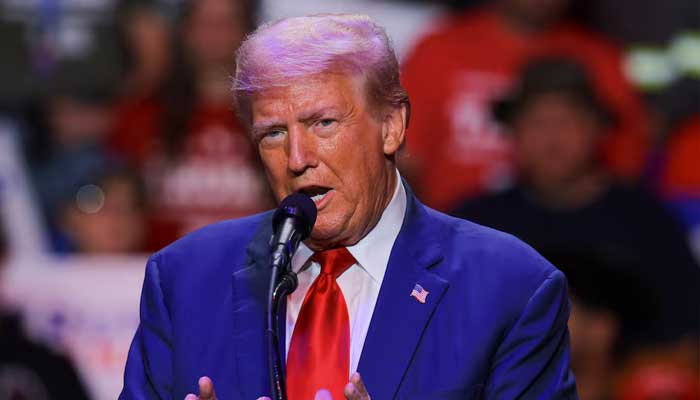
- Trump announces the imposition of 25% tariffs on all goods coming from three countries.
- Chinese embassy spokesman says no one will win in the trade war.
- Liu Bingyu says bilateral trade cooperation is mutually beneficial.
WASHINGTON: As people inside and outside the United States brace for major political changes in light of President-elect Donald Trump’s presidential election victory, the Republican said his intention is to impose sweeping tariffs on goods coming from Mexico, Canada and China.
“On January 20, as one of my first executive orders, I will sign all necessary documents to impose 25% tariffs on Mexico and Canada on all products coming into the United States,” Trump said on his Truth Social account.
Trump’s statement comes as he pledged, in a series of posts, to impose tariffs on some of the United States’ largest trading partners on all goods entering the country.
In an expansion of his policy towards China, Trump said he would also impose a 10% tariff on Beijing “on top of any additional tariffs,” in response to what he described as its failure to address fentanyl smuggling.
Tariffs remain a key part of his economic agenda, with the Republican vowing to impose wide-ranging tariffs on allies and adversaries alike during his election campaign.
There are no winners in a trade war
Both China and Canada issued quick responses, with each describing its trade relations with the United States as “mutually beneficial.”
“No one will win the trade war,” said Liu Bingyu, spokesman for the Chinese Embassy in the United States. Agence France-Presse via email, defending Beijing’s efforts to curb fentanyl trafficking.
“China believes that economic and trade cooperation between China and the United States is mutually beneficial in nature,” Liu added.
Meanwhile, Canada said it was “essential” to US energy supplies and insisted the relationship benefits US workers.
“We will of course continue to discuss these issues with the incoming administration,” said the statement issued by Deputy Prime Minister Chrystia Freeland.
Trump’s first term as president was marked by an aggressive and protectionist trade agenda that also targeted China, Mexico and Canada, in addition to Europe.
While in the White House, Trump launched an all-out trade war with China, imposing significant tariffs on hundreds of billions of dollars in Chinese goods.
At the time, he cited unfair trade practices, intellectual property theft, and trade deficits as justifications.
China responded by imposing retaliatory tariffs on American products, particularly affecting American farmers.
The United States, Mexico and Canada are bound by a three-decade-old free trade agreement, now called the USMCA, which was renegotiated under Trump after he complained that American companies, especially automakers, were losing out.
“Mexico and Canada remain highly dependent on the U.S. market, so their ability to deflect threats from President-elect Trump remains limited,” said Wendy Cutler, vice president of the Asia Society Policy Institute and a former U.S. trade official. Agence France-Presse.
By citing the fentanyl crisis and illegal immigration, Trump appeared to use national security concerns as a way to break that deal, something normally permitted under rules set by the World Trade Organization or in trade deals.
But most countries and the WTO treat national security exceptions as something to be used sparingly, rather than as a routine trade policy tool.
Trump in 2018 cited national security justifications for imposing tariffs on steel and aluminum imports that targeted close allies such as Canada, Mexico and the European Union.
This led to retaliatory measures from trading partners.
Growth is at risk and inflation is rising
Many economists have warned that tariffs will hurt growth and lead to higher inflation, since they are paid primarily by importers who bring goods into the United States, who often pass those costs on to consumers.
But those in Trump’s inner circle insist that tariffs constitute a useful bargaining chip for the United States to push its trading partners to agree to more favorable terms and bring back manufacturing jobs from abroad.
Trump said he would put Commerce Secretary-designate Howard Lutnick, a China hawk, in charge of trade policy.
Lutnick has expressed his support for a 60% tariff level on Chinese goods along with a 10% tariff on all other imports.
William Wrench, senior adviser at the Center for Strategic and International Studies, said that this was a classic move for Trump, who believed in the policy of “threat, then negotiate.”
“In terms of what might actually happen, I would bet on some Chinese tariffs going into effect,” he said. “This is easier from a legal standpoint and more acceptable from a political standpoint.”
“With regard to Canada and Mexico, there will be a renegotiation of their trade agreement (USMCA) in any case in 2026,” he added.
